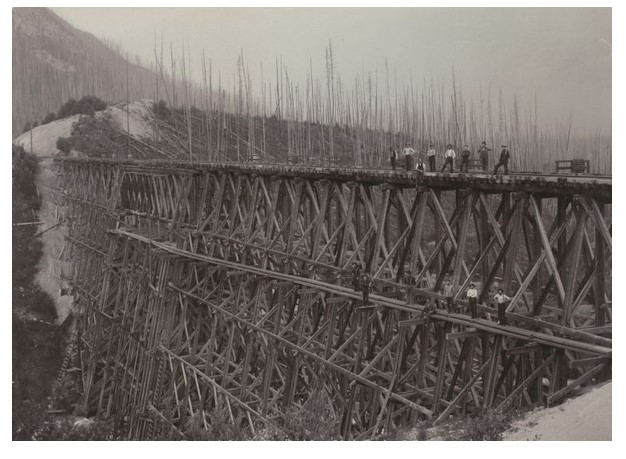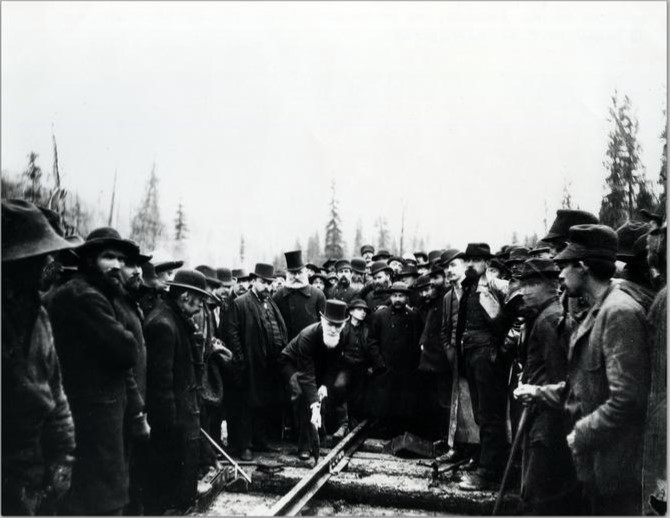Railways
The construction of railway networks is widely associated with nation- and empire-building in the nineteenth century. According to this view, the railway created new links between distant communities, enabling the transport of passengers and freight across vast continents in ever-increasing quantities. Despite its powerful associations with modernity and progress, however, the history of the railways is more complicated than this narrative would seem to suggest. In this session, we will examine how construction of railways and experiences of rail travel could differ significantly from place to place, despite utopian visions of the railway’s civilizing, modernizing effects.
Presenters — Emily Marsh and Nida Mahmud
Seminar Questions
- What elements make up ‘the philosophy of the railways’ according to den Otter?
- What does the history of the intercontinental railway reveal about the history of Canada?
- How does the story of railway construction differ in Canada and India? How is it similar?
- Did the construction of railway lines strengthen national and imperial ties, or undermine them?
Essential Reading
- Otter, A. A. den. The Philosophy of Railways: The Transcontinental Railway Idea in British North America. Toronto: University of Toronto Press, 1997. Chapter 1 and conclusion.
- Prasad, Ritika. Tracks of Change: Railways and Everyday Life in Colonial India. Cambridge: Cambridge University Press, 2015. Chapter 3.
- Kerr, Ian J. ‘Representation and Representations of the Railways of Colonial and Post-Colonial South Asia’. Modern Asian Studies 37, no. 2 (2003): 287-326.
Primary Source
- Gandhi, Mohandas. ‘IX – The Condition of India: Railways’. In ‘Hind Swaraj’ and Other Writings, edited by Anthony J. Parel, 45-48. Cambridge: Cambridge University Press, 2014.
Further Reading
- Aguiar, Marian. ‘Making Modernity: Inside the Technological Space of the Railway’. Cultural Critique 68 (1): 66-85.
- Aguiar, Marian. Tracking Modernity: India, Trains, and the Culture of Mobility. Minneapolis: University of Minnesota Press, 2011.
- Ahuja, Ravi. Pathways of Empire: Circulation, ‘Public Works’ and Social Space in Colonial Orissa c. 1780-1914. Hyderabad: Orient Black Swan, 2009.
- Bear, Laura. Lines of the Nation: Indian Railway Workers, Bureaucracy, and the Intimate Historical Self. New York: Columbia University Press, 2007.
- Davis, Clarence B., and Kenneth E. Wilburn, eds., Railway Imperialism. London: Greenwood Press, 1991.
- Falola, Toyin, and Emily Brownell, eds., Landscape, Environment and Technology in Colonial and Postcolonial Africa. New York: Routledge, 2013.
- Khatun, Samia. ‘Beyond Blank Spaces: Five Tracks to Late Nineteenth-Century Beltana’. Transfers 5, no. 3 (2015).
- Prasad, Ritika. ‘Smoke and Mirrors: Women and Railway Travel in Colonial South Asia’, South Asian History and Culture 3, 1 (2012): 22-46.
- Richards, Jeffrey. The Railway Station: A Social History. Oxford: Oxford University Press, 1986.
- Schivelbush, Wolfgang. The Railway Journey: The Industrialization of Time and Space in the Nineteenth Century. Berkeley, CA: University of California Press, 1986.
- Sinha, Nitin. ‘Entering the Black Hole: Between “Mini-England” and “Smell-like Rotten Potato”, the Railway-Workshop Town of Jamalpur, 1860s–1940s’. South Asian History and Culture 3, no. 3 (2012): 317–47.
- Sinha, Nitin. Communication and Colonialism in Eastern India, Bihar: 1760s-1880s. London: Anthem Press, 2012.


